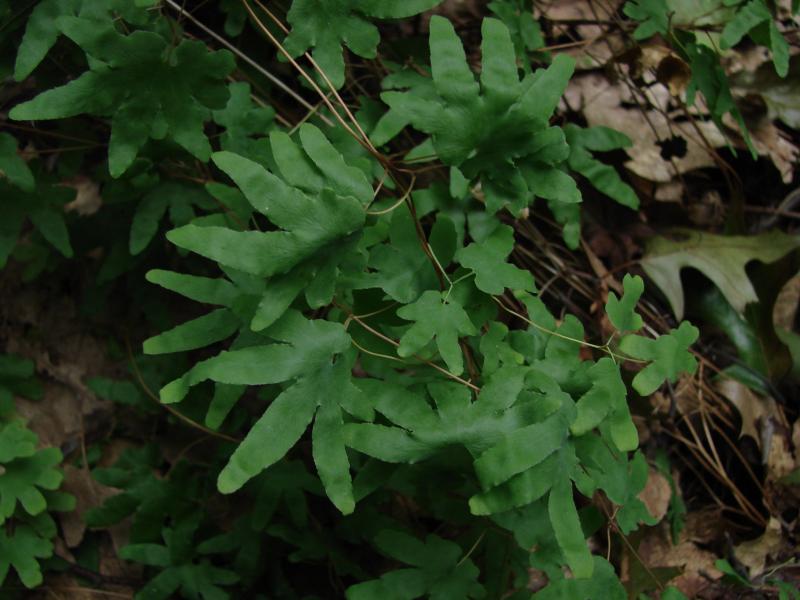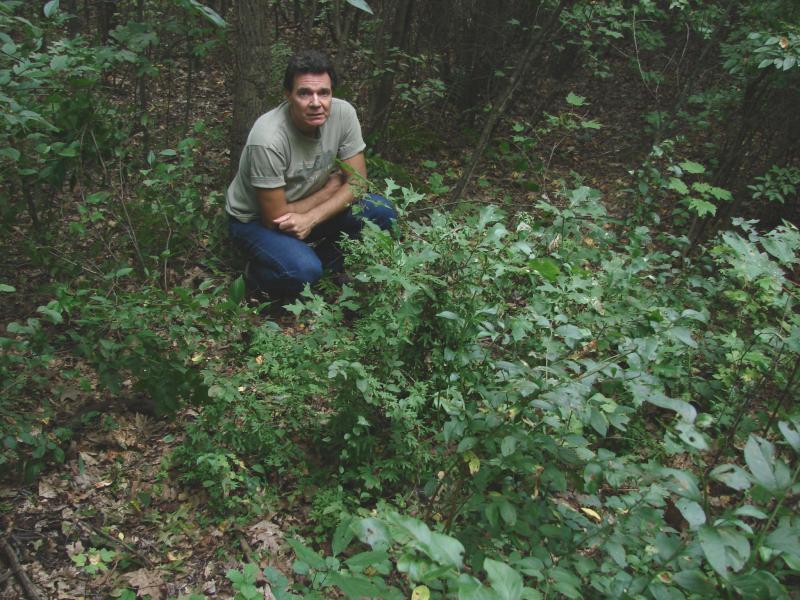Climbing Fern
Lygodium palmatum (Bernh.) Sw.
- Class
- Filicopsida (Ferns)
- Family
- Lygodiaceae (climbing fern family)
- State Protection
- Endangered
Listed as Endangered by New York State: in imminent danger of extirpation in New York. For animals, taking, importation, transportation, or possession is prohibited, except under license or permit. For plants, removal or damage without the consent of the landowner is prohibited.
- Federal Protection
- Not Listed
- State Conservation Status Rank
- S1
Critically Imperiled in New York - Especially vulnerable to disappearing from New York due to extreme rarity or other factors; typically 5 or fewer populations or locations in New York, very few individuals, very restricted range, very few remaining acres (or miles of stream), and/or very steep declines.
- Global Conservation Status Rank
- G4
Apparently Secure globally - Uncommon in the world but not rare; usually widespread, but may be rare in some parts of its range; possibly some cause for long-term concern due to declines or other factors.
Summary
Did you know?
This is our only fern that acts as a true vine, although it doesn't climb very high.
State Ranking Justification
There are four existing populations but they are small and only one of them is on protected land. There are only five other historical locations for this fern in New York, from 1868 to 1965, but three of them no longer exist.
Short-term Trends
The short-term trend appears stable as existing populations have not increased or decreased.
Long-term Trends
This plant has always been very rare in New York with less than 5 populations. It will continue to exist at low levels into the foreseeable future.
Conservation and Management
Threats
Populations are in unprotected areas that may be subject to future logging or development.
Conservation Strategies and Management Practices
Establish undisturbed buffer areas around the woodlands where populations occur.
Research Needs
Propagation studies are needed to see if populations can be augmented.
Habitat
Habitat
The relatively few sites for Climbing Fern in New York are scattered widely across the state and vary widely in their habitat characteristics as well. Known sites include woods within pitch-pine barrens, alder swamps, wet areas within successional hardwood forests, and coastal swamp forests (New York Natural Heritage Program 2011). Rare and local... not tolerant of shading (FNA 1993). Moist thickets and woods in acid soil (Gleason and Cronquist 1991).
Associated Ecological Communities
- Hemlock-hardwood swamp*
(guide)
A swamp that occurs on mineral soils and deep muck in depressions which receive groundwater discharge. These swamps usually have a fairly closed canopy (70 to 90% cover), sparse shrub layer, and low species diversity. The tree canopy is typically dominated by eastern hemlock and co-dominated by yellow birch and red maple.
- Pitch pine-heath barrens
(guide)
A shrub-savanna community that occurs on well-drained, sandy or rocky soils. The most abundant tree is pitch pine and the shrublayer is dominated by heath shrubs.
* probable association but not confirmed.
Associated Species
- Acer rubrum
- Acer saccharum (sugar maple)
- Aralia nudicaulis (wild sarsaparilla)
- Betula populifolia (gray birch)
- Carex pensylvanica (Pennsylvania sedge)
- Dalibarda repens
- Dendrolycopodium obscurum (flat-branched tree-clubmoss)
- Diphasiastrum digitatum (southern ground-cedar)
- Diphasiastrum tristachyum (blue ground-cedar)
- Dryopteris intermedia (evergreen wood fern, fancy wood fern, common wood fern)
- Kalmia angustifolia
- Liquidambar styraciflua (sweet-gum)
- Maianthemum canadense (Canada mayflower)
- Maianthemum trifolium (three-leaved Solomon's-seal)
- Mitchella repens (partridge-berry)
- Nyssa sylvatica (black-gum, sour-gum)
- Onoclea sensibilis (sensitive fern)
- Osmunda cinnamomea
- Osmunda regalis
- Pinus rigida (pitch pine)
- Pinus strobus (white pine)
- Prunus serotina
- Pteridium aquilinum
- Quercus palustris (pin oak)
- Quercus rubra (northern red oak)
- Quercus velutina (black oak)
- Sassafras albidum (sassafras)
- Smilax herbacea (common carrion-flower)
- Sphagnum
- Thelypteris noveboracensis (New York fern)
- Thelypteris palustris
- Tsuga canadensis (eastern hemlock)
- Vaccinium corymbosum (highbush blueberry)
- Waldsteinia fragarioides
Range
New York State Distribution
This fern is known from widely scattered historical occurrences from Long Island north to Greene County and west to Onondaga and Chemung counties. It is currently known from Staten Island, Saratoga and Oneida counties.
Global Distribution
This climbing fern is most common in the eastern mountains from Ohio, Kentucky, and Tennessee east to the Carolinas and Virginia although a few populations are on the coastal plain. It extends to the northeast through Maryland, Pennsylvania, New York, and New England but is considered rare in all of these states. There are a few disjunct populations in Michigan, Indiana, and Mississippi.
Identification Comments
General Description
The climbing fern has black wiry rhizomes that give rise to leaves that climb on surrounding vegetation to heights of up to 2 meters. The leaflets without spores are long-stalked, 2-4 cm long, 3-6 cm wide, heart-shaped at the base, and palmately lobed. The lobes are rounded above and with wavy smooth margins. The leaflets with spores are towards the top, much smaller, and several times branched with the ultimate segments only 3-5 mm long.
Best Life Stage for Proper Identification
This fern can be identified any time leaves are present.
Similar Species
There are no other vines or ferns that look like this species.
Best Time to See
An evergreen fern, Lygodium palmatum may be most conspicuous in the winter months when little other green vegetation is present.
- Vegetative
- Fruiting
The time of year you would expect to find Climbing Fern vegetative and fruiting in New York.
Climbing Fern Images
Taxonomy
Climbing Fern
Lygodium palmatum (Bernh.) Sw.
- Kingdom Plantae
- Phylum Filicinophyta
- Class Filicopsida
(Ferns)
- Order Filicales
- Family Lygodiaceae (climbing fern family)
- Order Filicales
- Class Filicopsida
(Ferns)
- Phylum Filicinophyta
Additional Common Names
- Creeping Fern
- Hartford Fern
Additional Resources
Best Identification Reference
Flora of North America Editorial Committee. 1993. Flora of North America, North of Mexico. Volume 2. Pteridophytes and Gymnosperms. Oxford University Press, New York. 475 pp.
Other References
Crow, Garrett E. 1982. New England's Rare, Threatened, and Endangered Plants. Prepared for the United States Department of Interior, Fish and Wildlife Service, Northeast Region. June 1982.
Fernald, M.L. 1950. Gray's manual of botany. 8th edition. D. Van Nostrand, New York. 1632 pp.
Gleason, Henry A. and A. Cronquist. 1991. Manual of Vascular Plants of Northeastern United States and Adjacent Canada. The New York Botanical Garden, Bronx, New York. 910 pp.
Holmgren, Noel. 1998. The Illustrated Companion to Gleason and Cronquist's Manual. Illustrations of the Vascular Plants of Northeastern United States and Adjacent Canada. The New York Botanical Garden, Bronx, New York.
Mitchell, Richard S. and Charles J. Sheviak. 1981. Rare Plants of New York State. Bull No. 445. New York State Museum. Univ. of New York. State Ed. Department Albany, NY.
New York Natural Heritage Program. 2010. Biotics database. New York Natural Heritage Program. New York State Department of Environmental Conservation. Albany, NY.
New York Natural Heritage Program. 2024. New York Natural Heritage Program Databases. Albany, NY.
Weldy, T. and D. Werier. 2010. New York flora atlas. [S.M. Landry, K.N. Campbell, and L.D. Mabe (original application development), Florida Center for Community Design and Research http://www.fccdr.usf.edu/. University of South Florida http://www.usf.edu/]. New York Flora Association http://newyork.plantatlas.usf.edu/, Albany, New York
Links
About This Guide
This guide was authored by: Stephen M. Young
Information for this guide was last updated on: September 6, 2012
Please cite this page as:
New York Natural Heritage Program. 2024.
Online Conservation Guide for
Lygodium palmatum.
Available from: https://guides.nynhp.org/climbing-fern/.
Accessed July 26, 2024.


